Recruitment Process Explained
VerifiedAdded on 2020/06/03
|9
|2843
|76
AI Summary
This assignment delves into the concept of recruitment, defining it as a systematic process employed by firms to identify and select qualified individuals for vacant positions. It emphasizes the selection criteria based on qualifications, skills, and knowledge relevant to the job requirements. The document explores the circumstances that trigger recruitment within companies and highlights the significance of this process in ensuring organizational success.
Contribute Materials
Your contribution can guide someone’s learning journey. Share your
documents today.
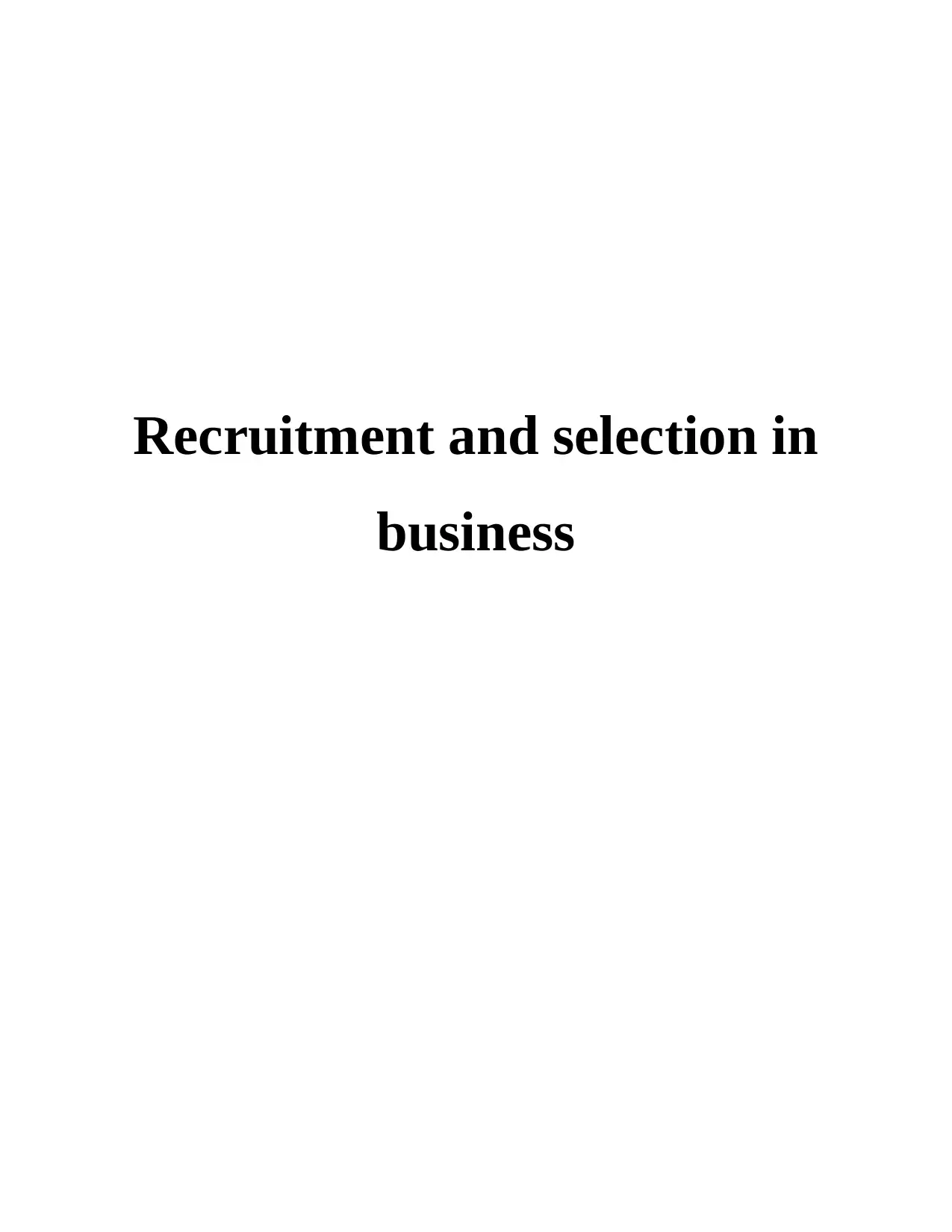
Recruitment and selection in
business
business
Secure Best Marks with AI Grader
Need help grading? Try our AI Grader for instant feedback on your assignments.
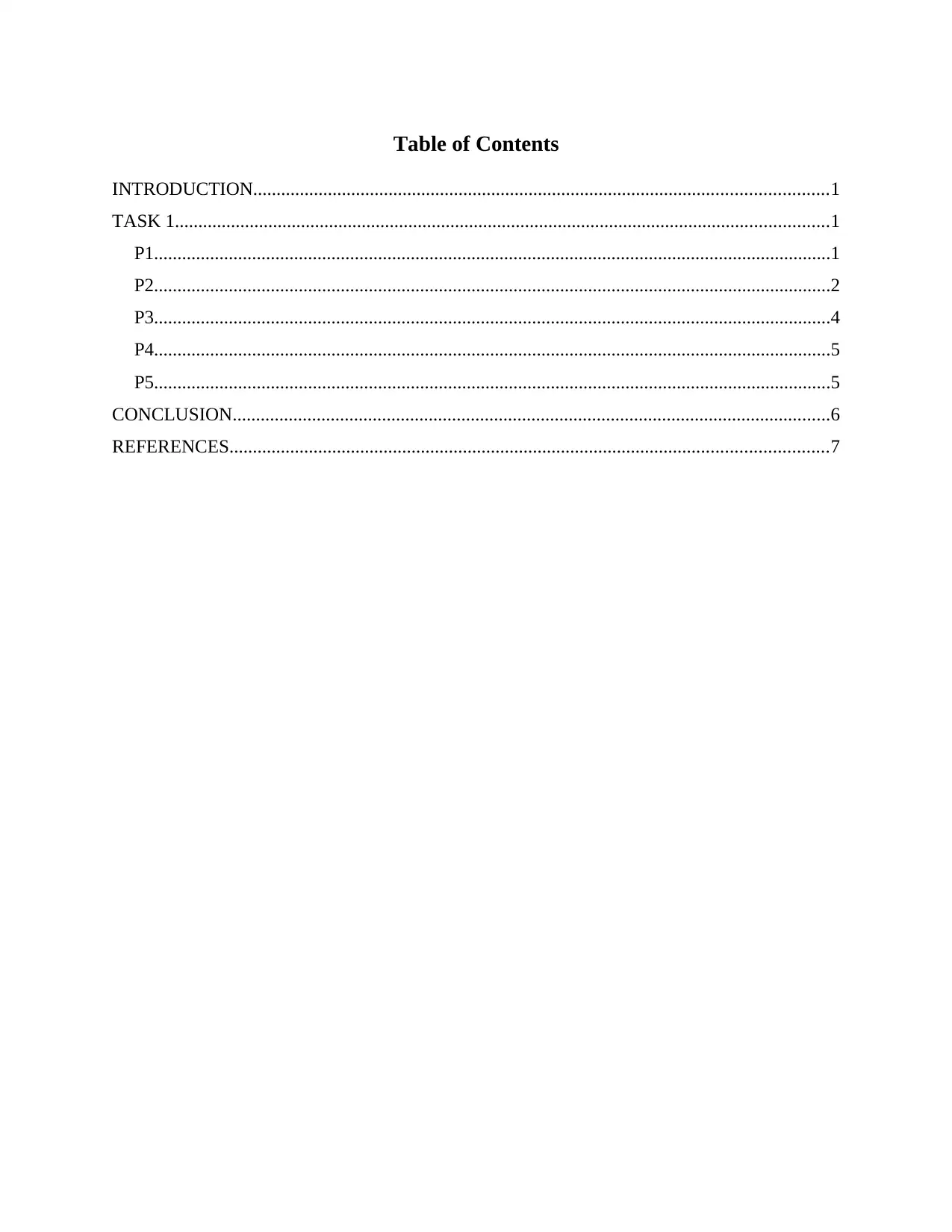
Table of Contents
INTRODUCTION...........................................................................................................................1
TASK 1............................................................................................................................................1
P1.................................................................................................................................................1
P2.................................................................................................................................................2
P3.................................................................................................................................................4
P4.................................................................................................................................................5
P5.................................................................................................................................................5
CONCLUSION................................................................................................................................6
REFERENCES................................................................................................................................7
INTRODUCTION...........................................................................................................................1
TASK 1............................................................................................................................................1
P1.................................................................................................................................................1
P2.................................................................................................................................................2
P3.................................................................................................................................................4
P4.................................................................................................................................................5
P5.................................................................................................................................................5
CONCLUSION................................................................................................................................6
REFERENCES................................................................................................................................7
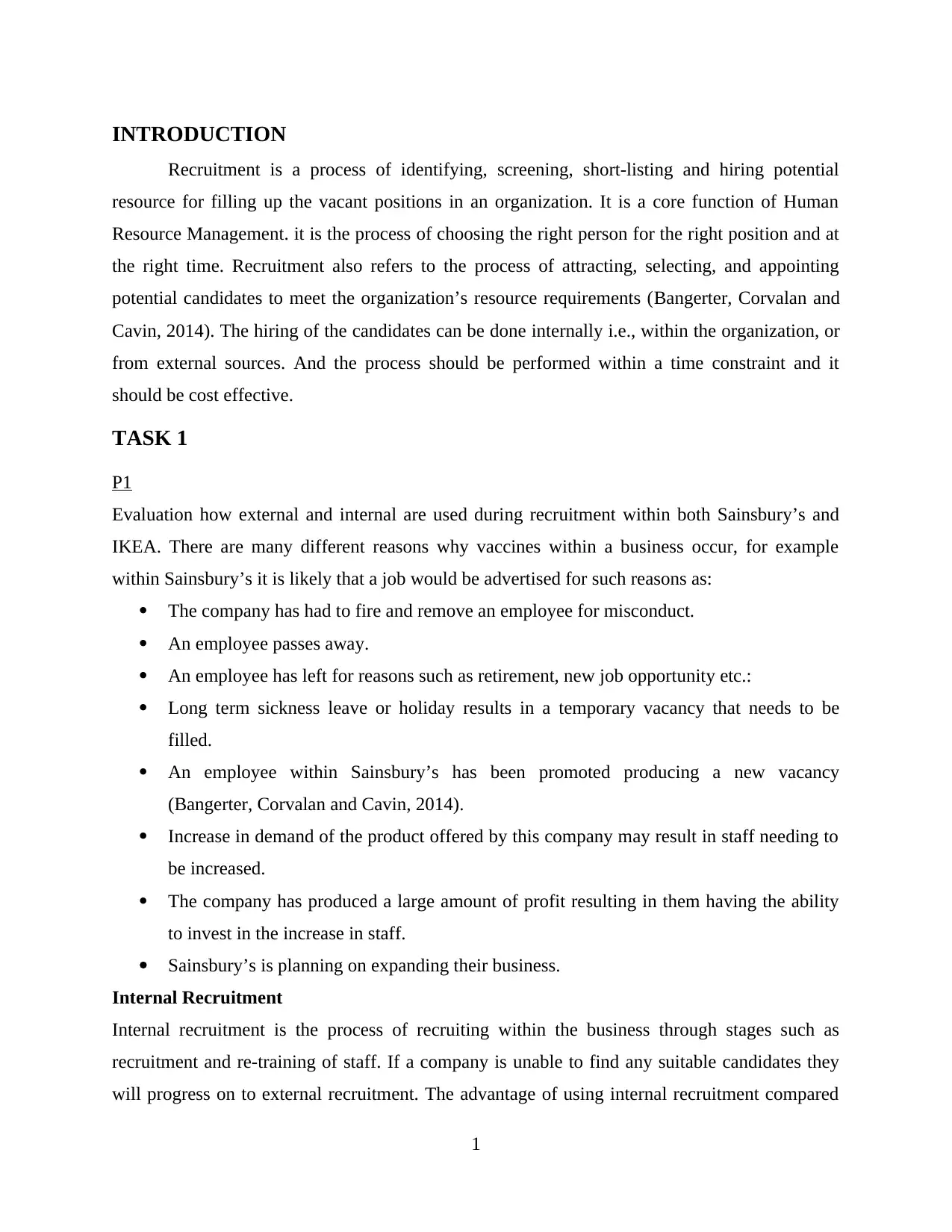
INTRODUCTION
Recruitment is a process of identifying, screening, short-listing and hiring potential
resource for filling up the vacant positions in an organization. It is a core function of Human
Resource Management. it is the process of choosing the right person for the right position and at
the right time. Recruitment also refers to the process of attracting, selecting, and appointing
potential candidates to meet the organization’s resource requirements (Bangerter, Corvalan and
Cavin, 2014). The hiring of the candidates can be done internally i.e., within the organization, or
from external sources. And the process should be performed within a time constraint and it
should be cost effective.
TASK 1
P1
Evaluation how external and internal are used during recruitment within both Sainsbury’s and
IKEA. There are many different reasons why vaccines within a business occur, for example
within Sainsbury’s it is likely that a job would be advertised for such reasons as:
The company has had to fire and remove an employee for misconduct.
An employee passes away.
An employee has left for reasons such as retirement, new job opportunity etc.:
Long term sickness leave or holiday results in a temporary vacancy that needs to be
filled.
An employee within Sainsbury’s has been promoted producing a new vacancy
(Bangerter, Corvalan and Cavin, 2014).
Increase in demand of the product offered by this company may result in staff needing to
be increased.
The company has produced a large amount of profit resulting in them having the ability
to invest in the increase in staff.
Sainsbury’s is planning on expanding their business.
Internal Recruitment
Internal recruitment is the process of recruiting within the business through stages such as
recruitment and re-training of staff. If a company is unable to find any suitable candidates they
will progress on to external recruitment. The advantage of using internal recruitment compared
1
Recruitment is a process of identifying, screening, short-listing and hiring potential
resource for filling up the vacant positions in an organization. It is a core function of Human
Resource Management. it is the process of choosing the right person for the right position and at
the right time. Recruitment also refers to the process of attracting, selecting, and appointing
potential candidates to meet the organization’s resource requirements (Bangerter, Corvalan and
Cavin, 2014). The hiring of the candidates can be done internally i.e., within the organization, or
from external sources. And the process should be performed within a time constraint and it
should be cost effective.
TASK 1
P1
Evaluation how external and internal are used during recruitment within both Sainsbury’s and
IKEA. There are many different reasons why vaccines within a business occur, for example
within Sainsbury’s it is likely that a job would be advertised for such reasons as:
The company has had to fire and remove an employee for misconduct.
An employee passes away.
An employee has left for reasons such as retirement, new job opportunity etc.:
Long term sickness leave or holiday results in a temporary vacancy that needs to be
filled.
An employee within Sainsbury’s has been promoted producing a new vacancy
(Bangerter, Corvalan and Cavin, 2014).
Increase in demand of the product offered by this company may result in staff needing to
be increased.
The company has produced a large amount of profit resulting in them having the ability
to invest in the increase in staff.
Sainsbury’s is planning on expanding their business.
Internal Recruitment
Internal recruitment is the process of recruiting within the business through stages such as
recruitment and re-training of staff. If a company is unable to find any suitable candidates they
will progress on to external recruitment. The advantage of using internal recruitment compared
1
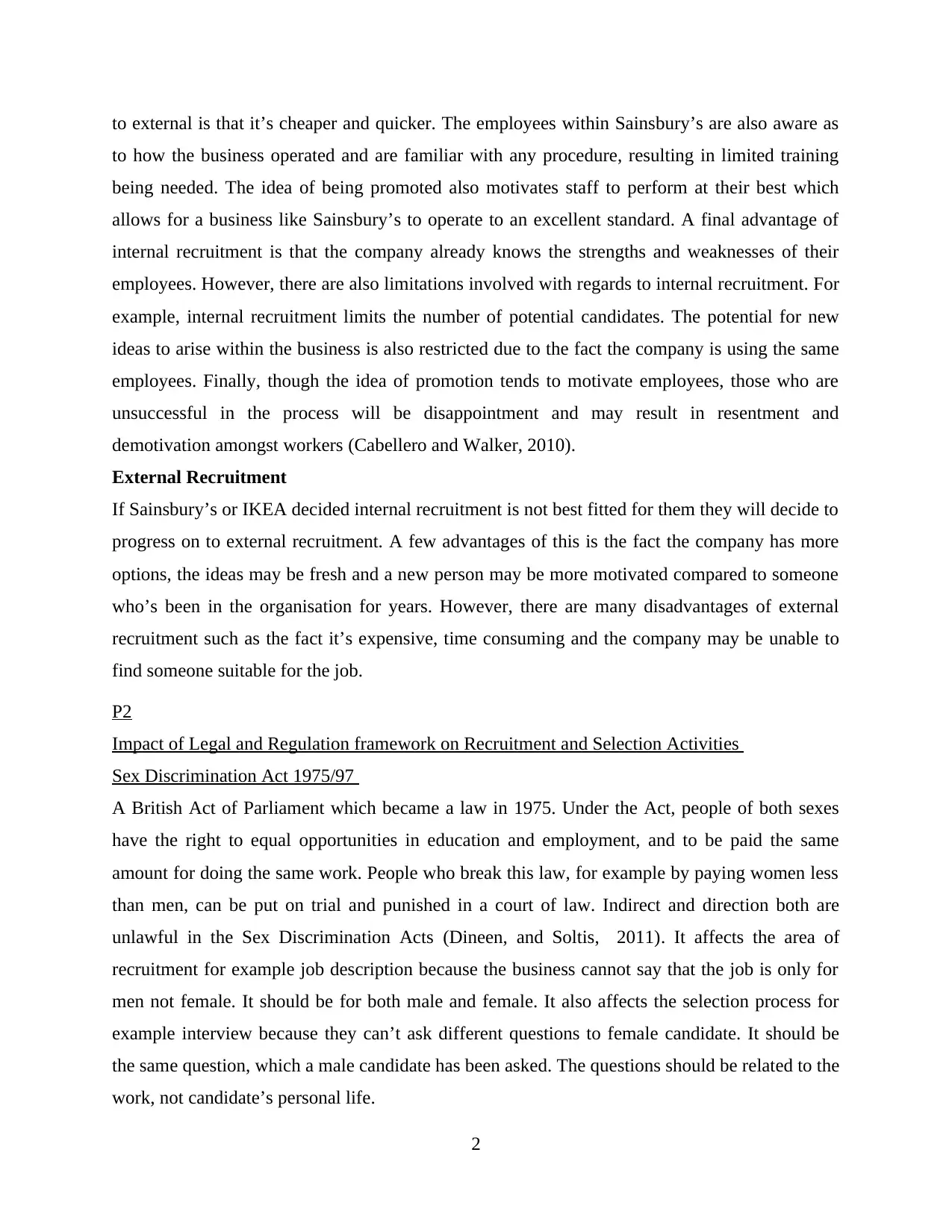
to external is that it’s cheaper and quicker. The employees within Sainsbury’s are also aware as
to how the business operated and are familiar with any procedure, resulting in limited training
being needed. The idea of being promoted also motivates staff to perform at their best which
allows for a business like Sainsbury’s to operate to an excellent standard. A final advantage of
internal recruitment is that the company already knows the strengths and weaknesses of their
employees. However, there are also limitations involved with regards to internal recruitment. For
example, internal recruitment limits the number of potential candidates. The potential for new
ideas to arise within the business is also restricted due to the fact the company is using the same
employees. Finally, though the idea of promotion tends to motivate employees, those who are
unsuccessful in the process will be disappointment and may result in resentment and
demotivation amongst workers (Cabellero and Walker, 2010).
External Recruitment
If Sainsbury’s or IKEA decided internal recruitment is not best fitted for them they will decide to
progress on to external recruitment. A few advantages of this is the fact the company has more
options, the ideas may be fresh and a new person may be more motivated compared to someone
who’s been in the organisation for years. However, there are many disadvantages of external
recruitment such as the fact it’s expensive, time consuming and the company may be unable to
find someone suitable for the job.
P2
Impact of Legal and Regulation framework on Recruitment and Selection Activities
Sex Discrimination Act 1975/97
A British Act of Parliament which became a law in 1975. Under the Act, people of both sexes
have the right to equal opportunities in education and employment, and to be paid the same
amount for doing the same work. People who break this law, for example by paying women less
than men, can be put on trial and punished in a court of law. Indirect and direction both are
unlawful in the Sex Discrimination Acts (Dineen, and Soltis, 2011). It affects the area of
recruitment for example job description because the business cannot say that the job is only for
men not female. It should be for both male and female. It also affects the selection process for
example interview because they can’t ask different questions to female candidate. It should be
the same question, which a male candidate has been asked. The questions should be related to the
work, not candidate’s personal life.
2
to how the business operated and are familiar with any procedure, resulting in limited training
being needed. The idea of being promoted also motivates staff to perform at their best which
allows for a business like Sainsbury’s to operate to an excellent standard. A final advantage of
internal recruitment is that the company already knows the strengths and weaknesses of their
employees. However, there are also limitations involved with regards to internal recruitment. For
example, internal recruitment limits the number of potential candidates. The potential for new
ideas to arise within the business is also restricted due to the fact the company is using the same
employees. Finally, though the idea of promotion tends to motivate employees, those who are
unsuccessful in the process will be disappointment and may result in resentment and
demotivation amongst workers (Cabellero and Walker, 2010).
External Recruitment
If Sainsbury’s or IKEA decided internal recruitment is not best fitted for them they will decide to
progress on to external recruitment. A few advantages of this is the fact the company has more
options, the ideas may be fresh and a new person may be more motivated compared to someone
who’s been in the organisation for years. However, there are many disadvantages of external
recruitment such as the fact it’s expensive, time consuming and the company may be unable to
find someone suitable for the job.
P2
Impact of Legal and Regulation framework on Recruitment and Selection Activities
Sex Discrimination Act 1975/97
A British Act of Parliament which became a law in 1975. Under the Act, people of both sexes
have the right to equal opportunities in education and employment, and to be paid the same
amount for doing the same work. People who break this law, for example by paying women less
than men, can be put on trial and punished in a court of law. Indirect and direction both are
unlawful in the Sex Discrimination Acts (Dineen, and Soltis, 2011). It affects the area of
recruitment for example job description because the business cannot say that the job is only for
men not female. It should be for both male and female. It also affects the selection process for
example interview because they can’t ask different questions to female candidate. It should be
the same question, which a male candidate has been asked. The questions should be related to the
work, not candidate’s personal life.
2
Secure Best Marks with AI Grader
Need help grading? Try our AI Grader for instant feedback on your assignments.
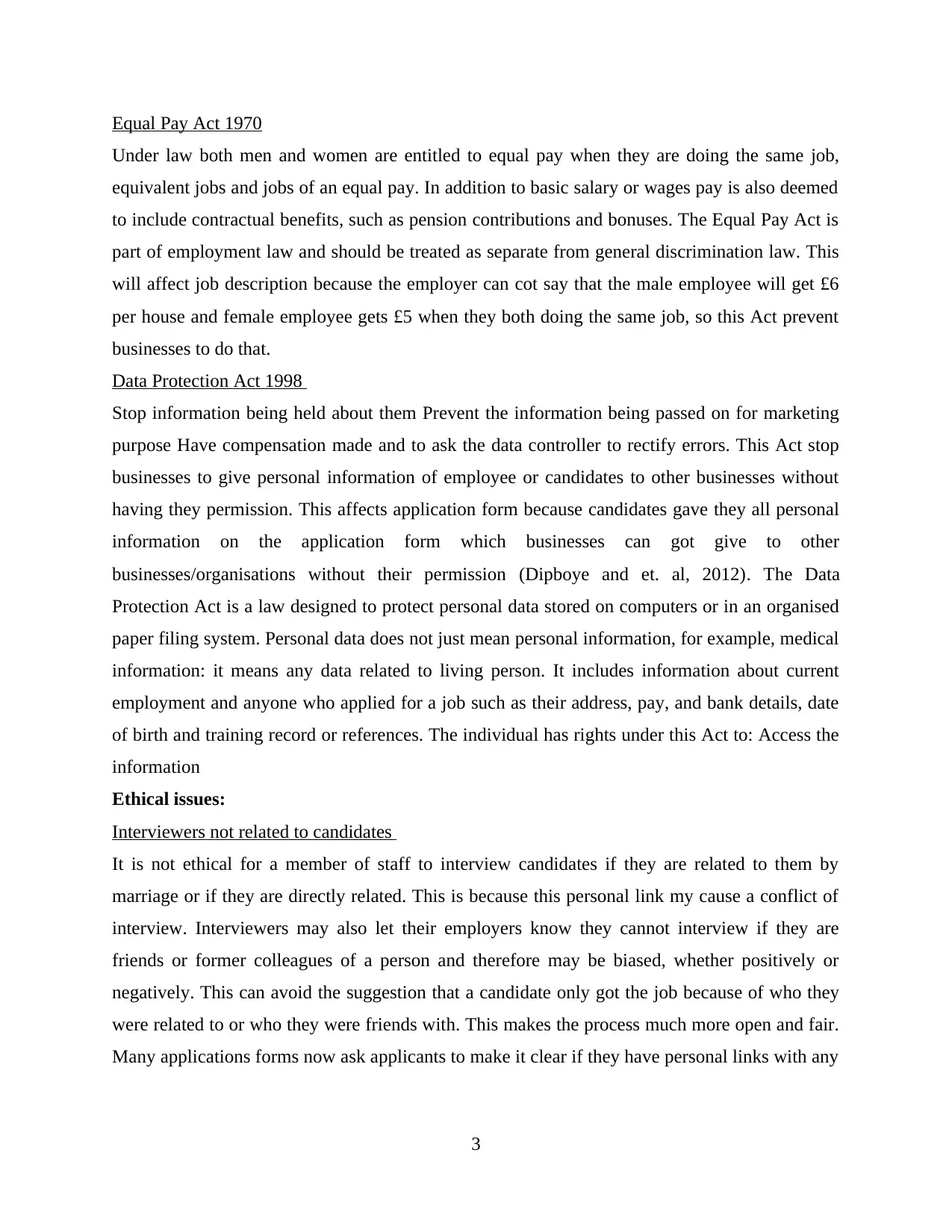
Equal Pay Act 1970
Under law both men and women are entitled to equal pay when they are doing the same job,
equivalent jobs and jobs of an equal pay. In addition to basic salary or wages pay is also deemed
to include contractual benefits, such as pension contributions and bonuses. The Equal Pay Act is
part of employment law and should be treated as separate from general discrimination law. This
will affect job description because the employer can cot say that the male employee will get £6
per house and female employee gets £5 when they both doing the same job, so this Act prevent
businesses to do that.
Data Protection Act 1998
Stop information being held about them Prevent the information being passed on for marketing
purpose Have compensation made and to ask the data controller to rectify errors. This Act stop
businesses to give personal information of employee or candidates to other businesses without
having they permission. This affects application form because candidates gave they all personal
information on the application form which businesses can got give to other
businesses/organisations without their permission (Dipboye and et. al, 2012). The Data
Protection Act is a law designed to protect personal data stored on computers or in an organised
paper filing system. Personal data does not just mean personal information, for example, medical
information: it means any data related to living person. It includes information about current
employment and anyone who applied for a job such as their address, pay, and bank details, date
of birth and training record or references. The individual has rights under this Act to: Access the
information
Ethical issues:
Interviewers not related to candidates
It is not ethical for a member of staff to interview candidates if they are related to them by
marriage or if they are directly related. This is because this personal link my cause a conflict of
interview. Interviewers may also let their employers know they cannot interview if they are
friends or former colleagues of a person and therefore may be biased, whether positively or
negatively. This can avoid the suggestion that a candidate only got the job because of who they
were related to or who they were friends with. This makes the process much more open and fair.
Many applications forms now ask applicants to make it clear if they have personal links with any
3
Under law both men and women are entitled to equal pay when they are doing the same job,
equivalent jobs and jobs of an equal pay. In addition to basic salary or wages pay is also deemed
to include contractual benefits, such as pension contributions and bonuses. The Equal Pay Act is
part of employment law and should be treated as separate from general discrimination law. This
will affect job description because the employer can cot say that the male employee will get £6
per house and female employee gets £5 when they both doing the same job, so this Act prevent
businesses to do that.
Data Protection Act 1998
Stop information being held about them Prevent the information being passed on for marketing
purpose Have compensation made and to ask the data controller to rectify errors. This Act stop
businesses to give personal information of employee or candidates to other businesses without
having they permission. This affects application form because candidates gave they all personal
information on the application form which businesses can got give to other
businesses/organisations without their permission (Dipboye and et. al, 2012). The Data
Protection Act is a law designed to protect personal data stored on computers or in an organised
paper filing system. Personal data does not just mean personal information, for example, medical
information: it means any data related to living person. It includes information about current
employment and anyone who applied for a job such as their address, pay, and bank details, date
of birth and training record or references. The individual has rights under this Act to: Access the
information
Ethical issues:
Interviewers not related to candidates
It is not ethical for a member of staff to interview candidates if they are related to them by
marriage or if they are directly related. This is because this personal link my cause a conflict of
interview. Interviewers may also let their employers know they cannot interview if they are
friends or former colleagues of a person and therefore may be biased, whether positively or
negatively. This can avoid the suggestion that a candidate only got the job because of who they
were related to or who they were friends with. This makes the process much more open and fair.
Many applications forms now ask applicants to make it clear if they have personal links with any
3
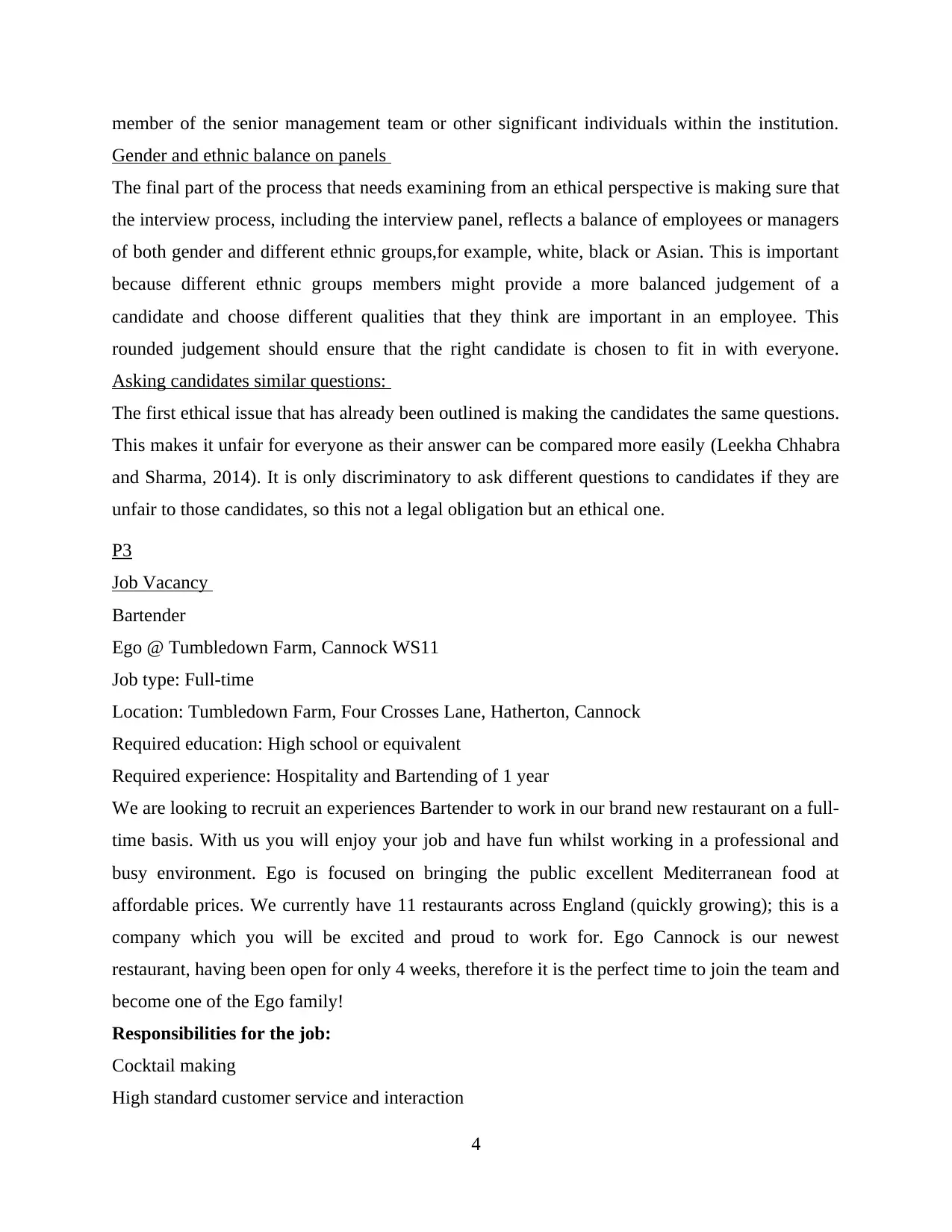
member of the senior management team or other significant individuals within the institution.
Gender and ethnic balance on panels
The final part of the process that needs examining from an ethical perspective is making sure that
the interview process, including the interview panel, reflects a balance of employees or managers
of both gender and different ethnic groups,for example, white, black or Asian. This is important
because different ethnic groups members might provide a more balanced judgement of a
candidate and choose different qualities that they think are important in an employee. This
rounded judgement should ensure that the right candidate is chosen to fit in with everyone.
Asking candidates similar questions:
The first ethical issue that has already been outlined is making the candidates the same questions.
This makes it unfair for everyone as their answer can be compared more easily (Leekha Chhabra
and Sharma, 2014). It is only discriminatory to ask different questions to candidates if they are
unfair to those candidates, so this not a legal obligation but an ethical one.
P3
Job Vacancy
Bartender
Ego @ Tumbledown Farm, Cannock WS11
Job type: Full-time
Location: Tumbledown Farm, Four Crosses Lane, Hatherton, Cannock
Required education: High school or equivalent
Required experience: Hospitality and Bartending of 1 year
We are looking to recruit an experiences Bartender to work in our brand new restaurant on a full-
time basis. With us you will enjoy your job and have fun whilst working in a professional and
busy environment. Ego is focused on bringing the public excellent Mediterranean food at
affordable prices. We currently have 11 restaurants across England (quickly growing); this is a
company which you will be excited and proud to work for. Ego Cannock is our newest
restaurant, having been open for only 4 weeks, therefore it is the perfect time to join the team and
become one of the Ego family!
Responsibilities for the job:
Cocktail making
High standard customer service and interaction
4
Gender and ethnic balance on panels
The final part of the process that needs examining from an ethical perspective is making sure that
the interview process, including the interview panel, reflects a balance of employees or managers
of both gender and different ethnic groups,for example, white, black or Asian. This is important
because different ethnic groups members might provide a more balanced judgement of a
candidate and choose different qualities that they think are important in an employee. This
rounded judgement should ensure that the right candidate is chosen to fit in with everyone.
Asking candidates similar questions:
The first ethical issue that has already been outlined is making the candidates the same questions.
This makes it unfair for everyone as their answer can be compared more easily (Leekha Chhabra
and Sharma, 2014). It is only discriminatory to ask different questions to candidates if they are
unfair to those candidates, so this not a legal obligation but an ethical one.
P3
Job Vacancy
Bartender
Ego @ Tumbledown Farm, Cannock WS11
Job type: Full-time
Location: Tumbledown Farm, Four Crosses Lane, Hatherton, Cannock
Required education: High school or equivalent
Required experience: Hospitality and Bartending of 1 year
We are looking to recruit an experiences Bartender to work in our brand new restaurant on a full-
time basis. With us you will enjoy your job and have fun whilst working in a professional and
busy environment. Ego is focused on bringing the public excellent Mediterranean food at
affordable prices. We currently have 11 restaurants across England (quickly growing); this is a
company which you will be excited and proud to work for. Ego Cannock is our newest
restaurant, having been open for only 4 weeks, therefore it is the perfect time to join the team and
become one of the Ego family!
Responsibilities for the job:
Cocktail making
High standard customer service and interaction
4
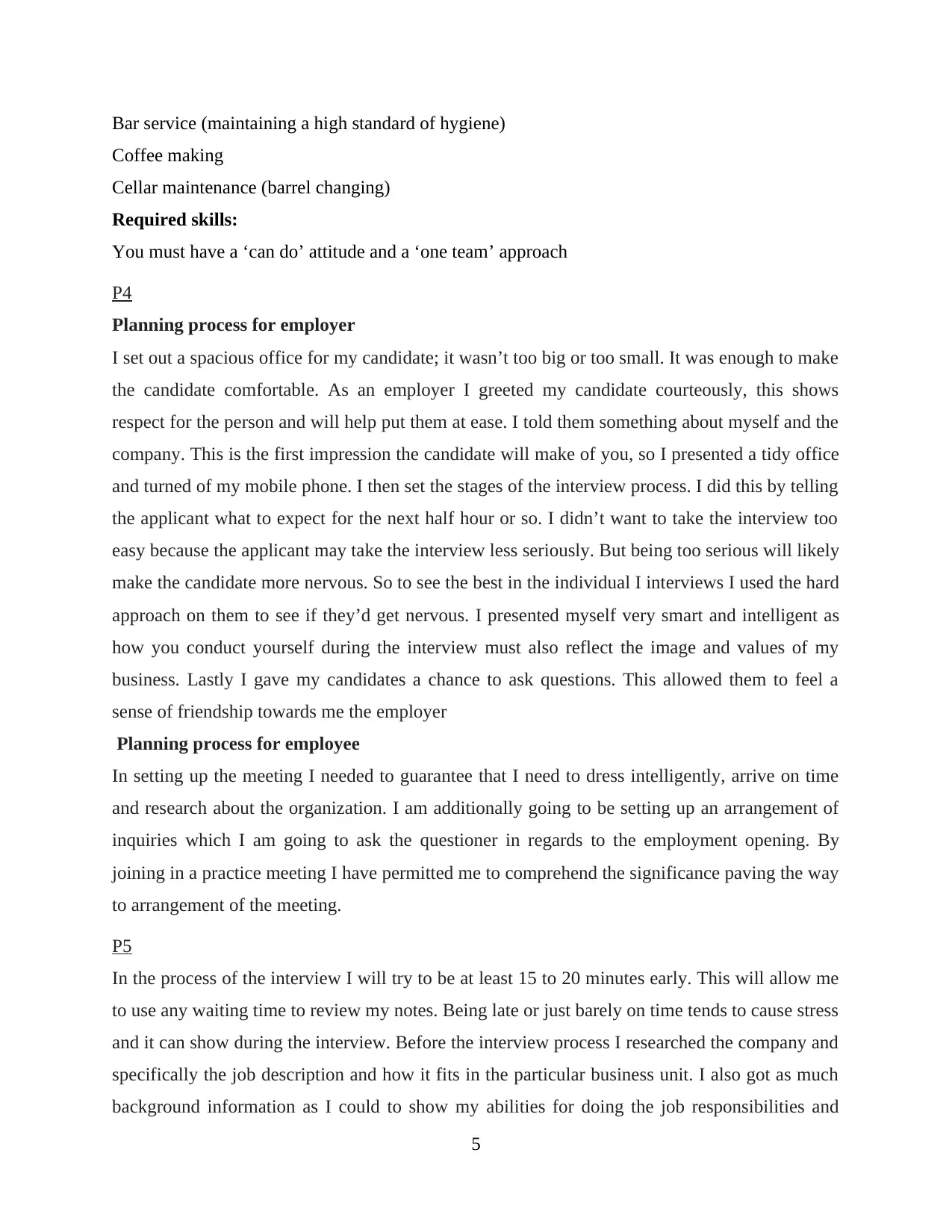
Bar service (maintaining a high standard of hygiene)
Coffee making
Cellar maintenance (barrel changing)
Required skills:
You must have a ‘can do’ attitude and a ‘one team’ approach
P4
Planning process for employer
I set out a spacious office for my candidate; it wasn’t too big or too small. It was enough to make
the candidate comfortable. As an employer I greeted my candidate courteously, this shows
respect for the person and will help put them at ease. I told them something about myself and the
company. This is the first impression the candidate will make of you, so I presented a tidy office
and turned of my mobile phone. I then set the stages of the interview process. I did this by telling
the applicant what to expect for the next half hour or so. I didn’t want to take the interview too
easy because the applicant may take the interview less seriously. But being too serious will likely
make the candidate more nervous. So to see the best in the individual I interviews I used the hard
approach on them to see if they’d get nervous. I presented myself very smart and intelligent as
how you conduct yourself during the interview must also reflect the image and values of my
business. Lastly I gave my candidates a chance to ask questions. This allowed them to feel a
sense of friendship towards me the employer
Planning process for employee
In setting up the meeting I needed to guarantee that I need to dress intelligently, arrive on time
and research about the organization. I am additionally going to be setting up an arrangement of
inquiries which I am going to ask the questioner in regards to the employment opening. By
joining in a practice meeting I have permitted me to comprehend the significance paving the way
to arrangement of the meeting.
P5
In the process of the interview I will try to be at least 15 to 20 minutes early. This will allow me
to use any waiting time to review my notes. Being late or just barely on time tends to cause stress
and it can show during the interview. Before the interview process I researched the company and
specifically the job description and how it fits in the particular business unit. I also got as much
background information as I could to show my abilities for doing the job responsibilities and
5
Coffee making
Cellar maintenance (barrel changing)
Required skills:
You must have a ‘can do’ attitude and a ‘one team’ approach
P4
Planning process for employer
I set out a spacious office for my candidate; it wasn’t too big or too small. It was enough to make
the candidate comfortable. As an employer I greeted my candidate courteously, this shows
respect for the person and will help put them at ease. I told them something about myself and the
company. This is the first impression the candidate will make of you, so I presented a tidy office
and turned of my mobile phone. I then set the stages of the interview process. I did this by telling
the applicant what to expect for the next half hour or so. I didn’t want to take the interview too
easy because the applicant may take the interview less seriously. But being too serious will likely
make the candidate more nervous. So to see the best in the individual I interviews I used the hard
approach on them to see if they’d get nervous. I presented myself very smart and intelligent as
how you conduct yourself during the interview must also reflect the image and values of my
business. Lastly I gave my candidates a chance to ask questions. This allowed them to feel a
sense of friendship towards me the employer
Planning process for employee
In setting up the meeting I needed to guarantee that I need to dress intelligently, arrive on time
and research about the organization. I am additionally going to be setting up an arrangement of
inquiries which I am going to ask the questioner in regards to the employment opening. By
joining in a practice meeting I have permitted me to comprehend the significance paving the way
to arrangement of the meeting.
P5
In the process of the interview I will try to be at least 15 to 20 minutes early. This will allow me
to use any waiting time to review my notes. Being late or just barely on time tends to cause stress
and it can show during the interview. Before the interview process I researched the company and
specifically the job description and how it fits in the particular business unit. I also got as much
background information as I could to show my abilities for doing the job responsibilities and
5
Paraphrase This Document
Need a fresh take? Get an instant paraphrase of this document with our AI Paraphraser
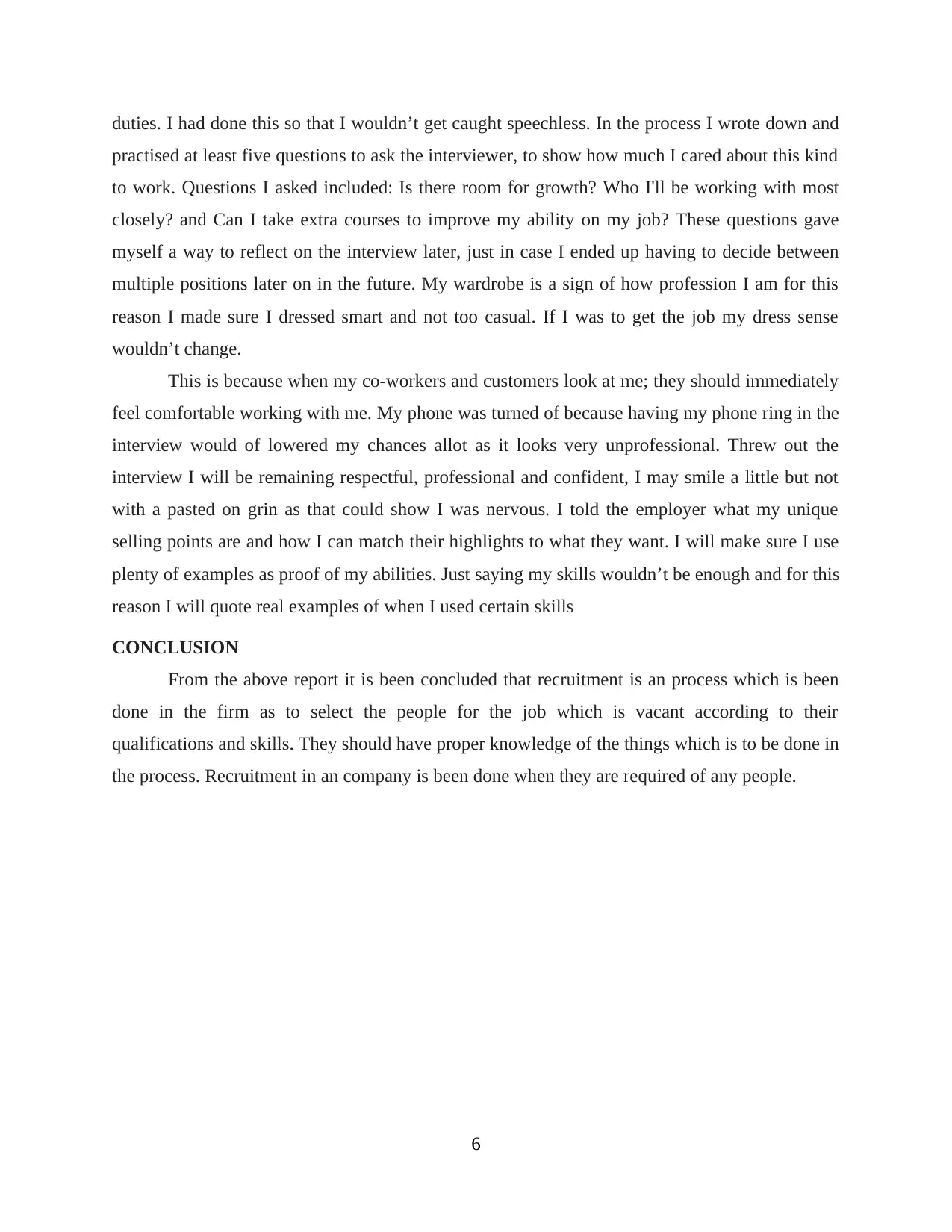
duties. I had done this so that I wouldn’t get caught speechless. In the process I wrote down and
practised at least five questions to ask the interviewer, to show how much I cared about this kind
to work. Questions I asked included: Is there room for growth? Who I'll be working with most
closely? and Can I take extra courses to improve my ability on my job? These questions gave
myself a way to reflect on the interview later, just in case I ended up having to decide between
multiple positions later on in the future. My wardrobe is a sign of how profession I am for this
reason I made sure I dressed smart and not too casual. If I was to get the job my dress sense
wouldn’t change.
This is because when my co-workers and customers look at me; they should immediately
feel comfortable working with me. My phone was turned of because having my phone ring in the
interview would of lowered my chances allot as it looks very unprofessional. Threw out the
interview I will be remaining respectful, professional and confident, I may smile a little but not
with a pasted on grin as that could show I was nervous. I told the employer what my unique
selling points are and how I can match their highlights to what they want. I will make sure I use
plenty of examples as proof of my abilities. Just saying my skills wouldn’t be enough and for this
reason I will quote real examples of when I used certain skills
CONCLUSION
From the above report it is been concluded that recruitment is an process which is been
done in the firm as to select the people for the job which is vacant according to their
qualifications and skills. They should have proper knowledge of the things which is to be done in
the process. Recruitment in an company is been done when they are required of any people.
6
practised at least five questions to ask the interviewer, to show how much I cared about this kind
to work. Questions I asked included: Is there room for growth? Who I'll be working with most
closely? and Can I take extra courses to improve my ability on my job? These questions gave
myself a way to reflect on the interview later, just in case I ended up having to decide between
multiple positions later on in the future. My wardrobe is a sign of how profession I am for this
reason I made sure I dressed smart and not too casual. If I was to get the job my dress sense
wouldn’t change.
This is because when my co-workers and customers look at me; they should immediately
feel comfortable working with me. My phone was turned of because having my phone ring in the
interview would of lowered my chances allot as it looks very unprofessional. Threw out the
interview I will be remaining respectful, professional and confident, I may smile a little but not
with a pasted on grin as that could show I was nervous. I told the employer what my unique
selling points are and how I can match their highlights to what they want. I will make sure I use
plenty of examples as proof of my abilities. Just saying my skills wouldn’t be enough and for this
reason I will quote real examples of when I used certain skills
CONCLUSION
From the above report it is been concluded that recruitment is an process which is been
done in the firm as to select the people for the job which is vacant according to their
qualifications and skills. They should have proper knowledge of the things which is to be done in
the process. Recruitment in an company is been done when they are required of any people.
6
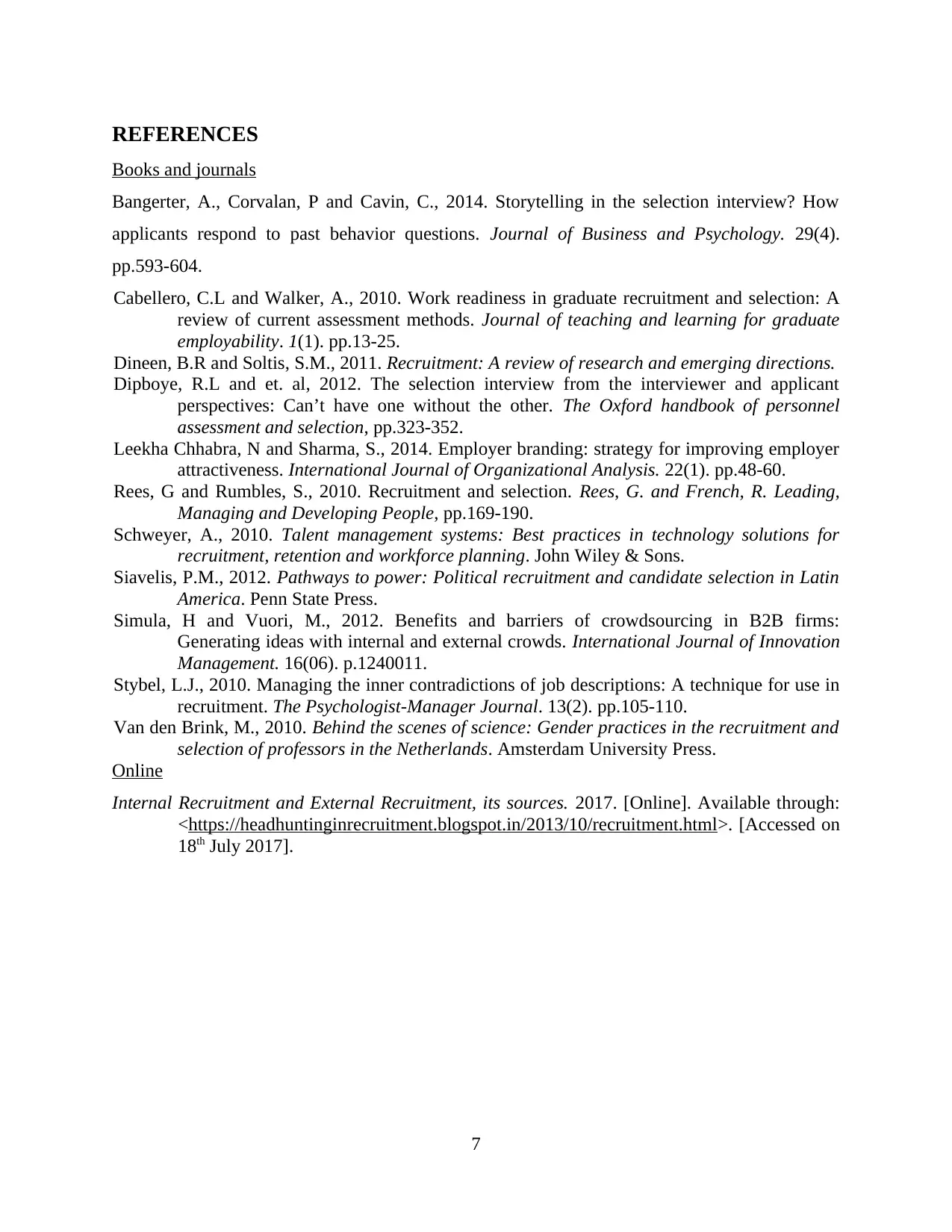
REFERENCES
Books and journals
Bangerter, A., Corvalan, P and Cavin, C., 2014. Storytelling in the selection interview? How
applicants respond to past behavior questions. Journal of Business and Psychology. 29(4).
pp.593-604.
Cabellero, C.L and Walker, A., 2010. Work readiness in graduate recruitment and selection: A
review of current assessment methods. Journal of teaching and learning for graduate
employability. 1(1). pp.13-25.
Dineen, B.R and Soltis, S.M., 2011. Recruitment: A review of research and emerging directions.
Dipboye, R.L and et. al, 2012. The selection interview from the interviewer and applicant
perspectives: Can’t have one without the other. The Oxford handbook of personnel
assessment and selection, pp.323-352.
Leekha Chhabra, N and Sharma, S., 2014. Employer branding: strategy for improving employer
attractiveness. International Journal of Organizational Analysis. 22(1). pp.48-60.
Rees, G and Rumbles, S., 2010. Recruitment and selection. Rees, G. and French, R. Leading,
Managing and Developing People, pp.169-190.
Schweyer, A., 2010. Talent management systems: Best practices in technology solutions for
recruitment, retention and workforce planning. John Wiley & Sons.
Siavelis, P.M., 2012. Pathways to power: Political recruitment and candidate selection in Latin
America. Penn State Press.
Simula, H and Vuori, M., 2012. Benefits and barriers of crowdsourcing in B2B firms:
Generating ideas with internal and external crowds. International Journal of Innovation
Management. 16(06). p.1240011.
Stybel, L.J., 2010. Managing the inner contradictions of job descriptions: A technique for use in
recruitment. The Psychologist-Manager Journal. 13(2). pp.105-110.
Van den Brink, M., 2010. Behind the scenes of science: Gender practices in the recruitment and
selection of professors in the Netherlands. Amsterdam University Press.
Online
Internal Recruitment and External Recruitment, its sources. 2017. [Online]. Available through:
<https://headhuntinginrecruitment.blogspot.in/2013/10/recruitment.html>. [Accessed on
18th July 2017].
7
Books and journals
Bangerter, A., Corvalan, P and Cavin, C., 2014. Storytelling in the selection interview? How
applicants respond to past behavior questions. Journal of Business and Psychology. 29(4).
pp.593-604.
Cabellero, C.L and Walker, A., 2010. Work readiness in graduate recruitment and selection: A
review of current assessment methods. Journal of teaching and learning for graduate
employability. 1(1). pp.13-25.
Dineen, B.R and Soltis, S.M., 2011. Recruitment: A review of research and emerging directions.
Dipboye, R.L and et. al, 2012. The selection interview from the interviewer and applicant
perspectives: Can’t have one without the other. The Oxford handbook of personnel
assessment and selection, pp.323-352.
Leekha Chhabra, N and Sharma, S., 2014. Employer branding: strategy for improving employer
attractiveness. International Journal of Organizational Analysis. 22(1). pp.48-60.
Rees, G and Rumbles, S., 2010. Recruitment and selection. Rees, G. and French, R. Leading,
Managing and Developing People, pp.169-190.
Schweyer, A., 2010. Talent management systems: Best practices in technology solutions for
recruitment, retention and workforce planning. John Wiley & Sons.
Siavelis, P.M., 2012. Pathways to power: Political recruitment and candidate selection in Latin
America. Penn State Press.
Simula, H and Vuori, M., 2012. Benefits and barriers of crowdsourcing in B2B firms:
Generating ideas with internal and external crowds. International Journal of Innovation
Management. 16(06). p.1240011.
Stybel, L.J., 2010. Managing the inner contradictions of job descriptions: A technique for use in
recruitment. The Psychologist-Manager Journal. 13(2). pp.105-110.
Van den Brink, M., 2010. Behind the scenes of science: Gender practices in the recruitment and
selection of professors in the Netherlands. Amsterdam University Press.
Online
Internal Recruitment and External Recruitment, its sources. 2017. [Online]. Available through:
<https://headhuntinginrecruitment.blogspot.in/2013/10/recruitment.html>. [Accessed on
18th July 2017].
7
1 out of 9
Related Documents
Your All-in-One AI-Powered Toolkit for Academic Success.
+13062052269
info@desklib.com
Available 24*7 on WhatsApp / Email
![[object Object]](/_next/static/media/star-bottom.7253800d.svg)
Unlock your academic potential
© 2024 | Zucol Services PVT LTD | All rights reserved.





